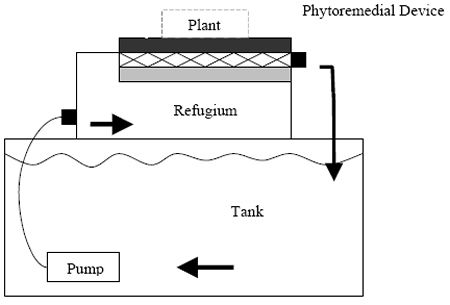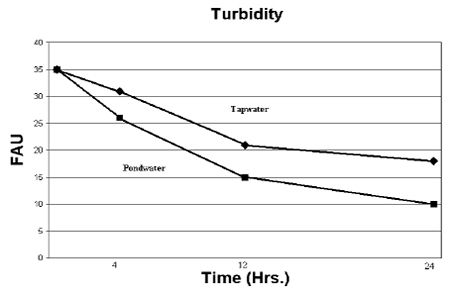The Use of an Upflow Refugium and Phytoremedial Device for Water Purification in Clinical Pet Fish Practice
Abstract
A phytoremedial device,1 coupled with an upflow refugium, functioned efficiently for water purification in koi ponds and in tanks with high stocking density over extended periods of time (Figure 1).
The design of this system utilized the biofiltration capabilities of the device to convert ammonia to nitrite to nitrate with uptake and utilization by the terrestrial plant impatiens, Impatiens sp. Coupled with this function was the abundant microfauna of protists and daphnia removing small, suspended particulates. Key to the effective function of the refugium is the elevated production of agglutinates. These substances are probably produced by the abundant nematodes found in the device and are transferred to the water (Figure 2). Removal of small particulates is accomplished by their agglutination into larger masses, with an increase in density allowing for settlement against the upward water flow. This allows the refugium to function efficiently with these devices placed anywhere in the aquasystem and with no filtration media to require cleaning.
In hospital quarantine tanks used for treatment in pet fish practice, this system presents a significant cost savings by reducing a) initial equipment cost; b) floor space needed to house and treat large specimen koi; c) time spent on capture and restraint; d) time spent on cleaning filters and changing water.
Case #1: History: A 13" (32.5 cm.) koi Cyprinus carpio weighing 946 gms. was hospitalized for treatment of ulcer disease and secondary saprolegniasis.
Discussion: The hospital quarantine setup consisted of a 30 gal. (113.5 l.) plastic tub and upflow refugia. A submersible pump without prefilter delivered water at approximately 200 GPH to the refugia. A heater maintained water temperature at 75° F. (24°C.). Treatment included injections of enrofloxacin (Baytril® 11 mg./kg.) on days 1,2,3,5 and 7 and potassium permanganate dip (100mg/l.) on day 17. Partial water changes were done on days 2, 12, 17 and 24. On day 24, a mature phytoremedial device was added to the refugium. For a period of 6 weeks, no further water changes were made. Sodium bicarbonate was added periodically to maintain pH stability. The stocking density was 8.3gms./l. This is greater than 4 times the maximum recommended stocking density of 2gms./l. for this species.² High water quality was maintained, with nitrates averaging about 70 mg./l. Though the health of the fish remained excellent, this was above the desirable limit of 50 mg./l. for this species. A larger or second refugium with 2 devices or a reduced stocking density is recommended.
In the field, improvement of poor water quality in koi ponds can be achieved with relatively low cost and minimal disturbance to existing landscaping.
Case#2: History: A Koi pond of 1200 gal. (4542 l.), containing 10 koi with a total weight of approximately 5000 gms. (1.1 gms./l.) was seen for ulcer disease problems.
Discussion: The pond, which was deep, featured a circulation and filtration system designed for shallow water ponds. Enlargement of the existing pond or the addition of a bottom drain was not possible without major structural changes. An upflow refugium of 450 gallons (1703 l.) was built 30 ft. uphill from the existing pond. A submersible pump, placed on the near side of the pond bottom, delivered 500 GPH to the bottom of the refugia, which then emptied into the existing waterfall, returning to the far side of the pond. Several phytoremedial device units were placed in the pond. Results: The water quality was significantly improved and after a course of oxytetracycline food administration, the ulcer disease problems resolved. The stocking density decreased to 0.8 gms./l.
Case #3: History: A lightly stocked koi pond of 1250 gals. (4732 l.), containing 8 koi with a total weight of approximately 2300 gms. (0.5 gms./l.) was seen for koi ulcer and generalized skin disease. Some deaths had occurred.
Discussion: The pond, of uniform depth of approximately 2 ft. (60 cm.) featured a pump drawing water from below the waterfall and into an external filter chamber, returning via the waterfall. The filter and pump sponge prefilter required daily cleaning. The water was murky (T0--43 FAU, T10--43 FAU). Microscopically, 40% of the suspended material was small fecal debris. An upflow refugium of 350 gallons (1325 l.) was built behind and flowing into the waterfall at the far side of the pond. Water was delivered to the bottom of the refugia by a 500 GPH pump without the sponge prefilter. This was placed on the bottom of the near side of the pond. Several phytoremedial device units were placed in the refugia and pond. The pond sides were also raised 8 inches (20 cm.).Results: Despite treatment with food containing ormetoprim-sulfadimethoxine (Romet®) and enrofloxacin (Baytril® 11mg./kg.) by injection (1 fish), only 2 fish survived until the above mentioned changes were completed. Water quality improved significantly (T0--3, T10--3) and the pond was restocked to approximately 4000 gms. of fish. The stocking density remained approximately 0.5 gms./l.
| Figure 1. | 
|
|
| |
| Figure 2. | 
|
|
| |
References
1. Tepper JM. 2000. A phytoremedial device for koi ponds. Proceedings, Joint Conference, American Association of Zoo Veterinarians and International Association for Aquatic Animal Medicine. P.551.
2. Wildgoose William H. 2001, British Small Animal Veterinary Association, Manual of Ornamental Fish, 2nd Edition. P.30.